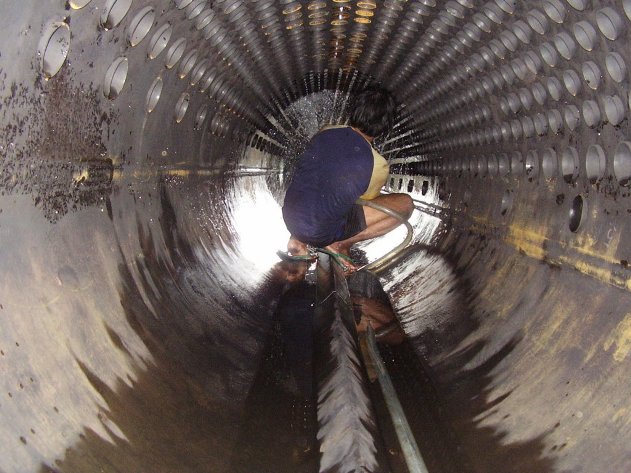Boiler preservation is required when boiler is out of service or in shutdown condition for a long period to protect boilers internal surface from corrosion and atmospheric oxygen.
There are two types of boiler preservation methods each of them is used in specific conditions.
- Wet preservation of boiler
- Dry preservation of boiler
Boiler preservation through nitrogen method is also used in power plant boilers.
These methods are designed to limit corrosion caused by the normal range of boiler and atmospheric contaminants.
Wet Preservation of boiler
If Boilers are required in stand by condition for sudden and quick demands of steam are preserved by the wet method. This method is also used for large boiler units which are difficult to drain.
Total Boiler pressure parts economiser, steam drum, water walls, super heater tube are filled with feed water having high concentration of Hydrazine (200 PPM). Such high concentration of hydrazine ensures, there is no dissolved oxygen available in feed water. Boiler is kept under pressure, so that atmospheric air can’t enter in to Boiler pressure parts.
Procedure of wet Preservation
The boiler should be filled with feedwater to the normal water level then
90% water level of gauge glass. Maintain ph up to 9.5-11.
Hydrazine 200 PPM is to be dosesed with the water. Ensure uniform concentration.
The results of boiler water sample, in case of N2H4 level is low from 100ppm then to inject N2H4 and in case of N2H4 level is above 200ppm then to perform dilution process (by feeding water into boiler and by taking blow down frequency.
Sodium sulphite (Na2SO3) 300-400 PPM can also be used if Haydazine is not available in case.
The boiler should be steamed to circulate chemicals to uniform concentration.
Do not use wet preservation method in very cold environment minus zero temperature or freezing water condition.
Dry Preservation of boiler
This method is used when boiler is required to be shutdown for a long period. Dry layup requires the removal of all water and the moisture of air to maintain a relative humidity less than 50%, and preferably less than 40%. This prevents corrosion by hygroscopic salts. Dry-air (dehumidified) storage is highly effective, and its continued effectiveness is easy to monitor. Dry layup allows easy and safe access for maintenance, with no potential for suffocation and no exposure to toxic chemicals.
Procedure for Dry preservation of boiler
The water is to be drained out of the boiler. The drum man hole, super heater, blowdown, air cocks, gauge glass and waterwall box drains should be opened.
Completely dryout the internal surface of boiler with hot air.
After drying silica gel on activated alumina (1.3 kg/m3 or 0.25 kg/m2 of heating surface) should be placed inside the drum. Unslaked lime (5.1 kg/m3 of heating surface can also be used as dessicant.
Closed airtight all the pressure parts so that no moisture and air leaks in.
Boiler inspection should be carried out once a month.
Replace the lime trays if necessary.
Nitrogen preservation
In the Steam generators even where water is present, corrosion can be prevented by eliminating oxygen from the environment. Oxygen can be eliminated by sealing and pressurizing the entire boiler, or the space above water level, with nitrogen to prevent air in leakage. In the absence of acids and other oxidants, eliminating air stops corrosion. Nitrogen blanketing is a highly effective method for preventing corrosion. It is easy to monitor its pressure and alarm, so effective preservation can be assured. However, the boiler must be well sealed to prevent excessive leakage.
 Boilersinfo Boiler and Mechanical Power Digital Library
Boilersinfo Boiler and Mechanical Power Digital Library

